CdTe Based Energy Resolving, X-ray Photon Counting Detector Performance Assessment: The Effects of Charge Sharing Correction Algorithm Choice
Abstract
1. Introduction
2. Materials and Methods
2.1. Monte Carlo Parameters
2.2. Finite Element Parameters
2.3. Supervisory Gate Script Parameters
2.4. Charge Sharing Correction Algorithms Considered
2.5. Setting Energy Bin Thresholds
2.6. Metrics Used to Assess Detector Performance
2.7. Theoretical Absolute Detection Efficiency Model
- Calculate the probability of an incident photon photoelectrically interacting with the detector such that it produces a count in the detector, PI, using the equationwhere ρ is the density of CdTe, T is the pixel thickness, and M is the mass attenuation coefficient.PI = 1 − e−MρT
- Calculate the number of incident photons per pixel per second, Fpix, using the equationwhere Fdet is the flux incident on the detector (in units of photons mm−2 s−1) and A is the area of pixel with the pitch being investigated.Fpix = Fdet A
- The rate at which incident photons interact with the sensor material, RI, is then given by the equationRI = Fpix PI
- For an idealised detector with no charge sharing we assume photon interactions deposit their energy at a single point in space and time. Assuming that the photon interactions with a given pixel follow a Poisson distribution, we can calculate the probability that two unrelated photons interact with the same pixel by chance within a time window tw. This probability, PT, is given by the equationPT = 1 − exp(−RItW)
- When tw represents the time required for two photons to be separately resolved by the detector, the number of uniquely detectable photon interactions, U, is given byU = RI (1 − PT)This approximation models a paralysable detector setup; however, the detectors in this work are non-paralysable, due to the reset triggers simulated. Equation (11) is thus not valid for high values of PT, however as the PT values considered in this work vary between 0.003 and 0.1, this equation should give an approximation sufficiently accurate for comparing the performance of the different CSCAs. It should again be stated at this point that the point of the current work is a qualitative comparison of the behaviours of the various CSCAs, and for this goal the estimate from Equation (11) is reasonable.
- Theoretical ADE values are then determined for this idealized detector according to the equationADE = U/Fpix
- Steps 1–6 are then repeated for each pixel pitch and flux considered in this work, to give a theoretical ADE value for each detector that can be used as a point of reference. CSCAs which produce ADE values above this theoretical ADE are imperfectly correcting for CSEs whilst those that produce ADE values below the theoretical value are amplifying the effects of pulse pileup.
2.8. Division of Results for Analysis
3. Results
3.1. Absolute Detection Efficiency
3.2. Absolute Photopeak Efficiency
3.3. Relative Coincidence Counts
3.4. Binned Spectral Efficiency
4. Discussion
4.1. Absolute Detection Efficiency
4.2. Absolute Photopeak Efficiency
4.3. Relative Coincidence Counts
4.4. Binned Spectral Efficiency
5. Conclusions
Author Contributions
Funding
Conflicts of Interest
References
- Symons, R.; Pourmorteza, A.; Sandfort, V.; Ahlman, M.A.; Cropper, T.; Mallek, M.; Malayeri, A.A. Feasibility of dose-reduced chest CT with photon-counting detectors: Initial results in humans. Radiology 2017, 285, 980–989. [Google Scholar] [CrossRef] [PubMed]
- Willemink, M.J.; Persson, M.; Pourmorteza, A.; Pelc, N.J.; Fleischmann, D. Photon-counting CT: Technical principles and clinical prospects. Radiology 2018, 289, 293–312. [Google Scholar] [CrossRef] [PubMed]
- Tao, S.; Marsh, J.F.; Tao, A.; Michalak, G.J.; Rajendran, K.; McCollough, C.H.; Leng, S. Multi-energy CT imaging for large patients using dual-source photon-counting detector CT. Phys. Med. Biol. 2020, 65, 17. [Google Scholar] [CrossRef] [PubMed]
- Koenig, T.; Schulze, J.; Zuber, M.; Rink, K.; Butzer, J.; Hamann, E.; Cecilia, A.; Zwerger, A.; Fauler, A.; Fiederle, M.; et al. Imaging properties of small-pixel spectroscopic X-ray detectors based on cadmium telluride sensors. Phys. Med. Biol. 2020, 57, 6743. [Google Scholar] [CrossRef] [PubMed]
- Simard, M.; Panta, R.K.; Bell, S.T.; Butler, A.P.; Bouchard, H. Quantitative imaging performance of MARS spectral photon-counting CT for radiotherapy. Med. Phys. 2020. [Google Scholar] [CrossRef] [PubMed]
- Cormode, D.P.; Si-Mohamed, S.; Bar-Ness, D.; Sigovan, M.; Naha, P.C.; Balegamire, J.; Rokni, M. Multicolor spectral photon-counting computed tomography: In vivo dual contrast imaging with a high count rate scanner. Sci. Rep. 2017, 7, 1–11. [Google Scholar] [CrossRef] [PubMed]
- Moghiseh, M.; Lowe, C.; Lewis, J.G.; Kumar, D.; Butler, A.; Anderson, N.; Raja, A. Spectral photon-counting molecular imaging for quantification of monoclonal antibody-conjugated gold nanoparticles targeted to lymphoma and breast cancer: An in vitro study. Contrast Media Mol. Imaging 2018. [Google Scholar] [CrossRef]
- Takahashi, T.; Watanabe, S. Recent progress in CdTe and CdZnTe 634 detectors. IEEE Trans. Nucl. Sci. 2001, 48, 950–959. [Google Scholar] [CrossRef]
- Soldner, S.A.; Bale, D.S.; Csaba, S. Dynamic lateral polarization in CdZnTe under high flux X-ray irradiation. IEEE Trans. Nucl. Sci. 2007, 54, 1723–1727. [Google Scholar] [CrossRef]
- Thomas, B.; Veale, M.C.; Wilson, M.D.; Seller, P.; Schneider, A.; Iniewski, K. Characterisation of Redlen high-flux CdZnTe. J. Instrum. 2017, 12, C12045. [Google Scholar] [CrossRef]
- Taguchi, K.; Iwanczyk, J.S. Vision 20/20: Single photon counting X-ray detectors in medical imaging. Med. Phys. 2013, 40, 100901. [Google Scholar] [CrossRef]
- Gimenez, E.N.; Ballabriga, R.; Campbell, M.; Horswell, I.; Llopart, X.; Marchal, J.; Sawhney KJ, S.; Tartoni, N.; Turecek, D. Characterization of Medipix3 with synchrotron radiation. IEEE Trans. Nucl. Sci. 2010, 58, 323–332. [Google Scholar] [CrossRef]
- Lee, O.; Kappler, S.; Polster, C.; Taguchi, K. Estimation of Basis Line-Integrals in a Spectral Distortion-Modeled Photon Counting Detector Using Low-Order Polynomial Approximation of X-ray Transmittance. IEEE Trans. Med. Imaging 2017, 36, 560–573. [Google Scholar] [CrossRef] [PubMed]
- Veale, M.C.; Bell, S.J.; Duarte, D.D.; Schneider, A.; Seller, P.; Wilson, M.D.; Iniewski, K. Measurements of charge sharing in small pixel CdTe detectors. Nucl. Instrum. Methods Phys. Res. Sect. A Accel. Spectrometers Detect. Assoc. Equip. 2014, 767, 218–226. [Google Scholar] [CrossRef]
- Di Trapani, V.; Bravin, A.; Brun, F.; Dreossi, D.; Longo, R.; Mittone, A.; Rigon, L.; Delogu, P. Characterization of the acquisition modes implemented in Pixirad-1/Pixie-III X-ray Detector: Effects of charge sharing correction on spectral resolution and image quality. Nucl. Instrum. Methods Phys. Res. Sect. A Accel. Spectrometers Detect. Assoc. Equip. 2020, 955, 163220. [Google Scholar] [CrossRef]
- Taguchi, K. Multi-energy inter-pixel coincidence counters for charge sharing correction and compensation in photon counting detectors. Med. Phys. 2020, 47, 2085–2098. [Google Scholar] [CrossRef] [PubMed]
- Ullberg, C.; Urech, M.; Weber, N.; Engman, A.; Redz, A.; Henckel, F. Measurements of a dual-energy fast photon counting CdTe detector with integrated charge sharing correction. Proc. SPIE 2013, 8668. [Google Scholar] [CrossRef]
- Ballabriga, R.; Campbell, M.; Heijne, E.H.M.; Llopart, X.; Tlustos, L. The Medipix3 prototype, a pixel readout chip working in single photon counting mode with improved spectrometric performance. IEEE Trans. Nucl. Sci. 2007, 54, 1824–1829. [Google Scholar] [CrossRef]
- Krzyżanowska, A.; Deptuch, G.W.; Maj, P.; Gryboś, P.; Szczygieł, R. Characterization of the photon counting CHASE Jr., chip built in a 40-nm CMOS process with a charge sharing correction algorithm using a collimated X-ray beam. IEEE Trans. Nucl. Sci. 2017, 64, 2561–2568. [Google Scholar] [CrossRef]
- Hsieh, S.S. Coincidence Counters for Charge Sharing Compensation in Spectroscopic Photon Counting Detectors. IEEE Trans. Med. Imaging 2019, 39, 678–687. [Google Scholar] [CrossRef]
- Persson, M.; Wang, A.; Pelc, N.J. Detective quantum efficiency of photon-counting CdTe and Si detectors for computed tomography: A simulation study. J. Med. Imaging 2020, 7. [Google Scholar] [CrossRef] [PubMed]
- Hsieh, S.S.; Rajbhandary, P.L.; Pelc, N.J. Spectral resolution and high-flux capability tradeoffs in CdTe detectors for clinical CT. Med. Phys. 2018, 45, 1433–1443. [Google Scholar] [CrossRef] [PubMed]
- Trueb, P.; Zambon, P.; Broennimann, C. Spectral performance of photon-counting detectors: How well can we capture the rainbow? In Spectral, Photon Counting Computed Tomography: Technology and Applications; Taguchi, K., Blevis, I., Iniewski, K., Eds.; CRC Press: Boca Raton, FL, USA, 2020; pp. 191–216. [Google Scholar]
- Pickford Scienti, O.; Shah, A.; Bamber, J.; Darambara, D. An Assessment of Photoacoustic and Photon Counting Multispectral x-Ray Imaging Techniques for Imaging Gold Nanorods in vivo as Part of Predicting Dose Enhancing Effects. In Proceedings of the 2016 IEEE Nuclear Science Symposium, Medical Imaging Conference and Room-Temperature Semiconductor Detector Workshop (NSS/MIC/RTSD), Strasbourg, France, 29 October–6 November 2016. [Google Scholar]
- Pickford Scienti, O.; Bamber, J.; Darambara, D. Inclusion of a Charge Sharing Correction Algorithm into an X-ray Photon Counting Spectral Detector Simulation Framework. Trans. Radiat. Plasma Med. Sci. 2020. [Google Scholar] [CrossRef]
- Jan, S.; Santin, G.; Strul, D.; Staelens, S.; Assie, K.; Autret, D.; Avner, S.; Barbier, R.; Bardies, M.; Bloomfield, P.M.; et al. GATE: A simulation toolkit for PET and SPECT. Phys. Med. Biol. 2004, 49, 4543–4561. [Google Scholar] [CrossRef] [PubMed]
- COMSOL Multiphysics®v5.2a. Available online: www.comsol.com (accessed on 7 September 2020).
- Ballabriga, R.; Alozy, J.; Bandi, F.N.; Campbell, M.; Edigos, N.; Fernandez-Tenllado, J.M.; Heijne EH, M.; Kremastiosis, I.; Llopart, X.; Madsen, B.J.; et al. Photon Counting Detectors for X-ray Imaging with Emphasis on CT. Trans. Radiat. Plasma Med. Sci. 2020. [Google Scholar] [CrossRef]
- Prettyman, T. Method for mapping charge pulses in semiconductor radiation detectors. Nucl. Instrum. Methods Phys. Res. Sect. A Accel. Spectrometers Detect. Assoc. Equip. 1999, 422, 232–237. [Google Scholar] [CrossRef]
- Myronakis, M.; Zvelebil, M.; Darambara, D. Computational modelling of pixelated CdZnTe detectors for X- and γ-ray imaging applications. J. Instrum. 2012, 7, 03004. [Google Scholar] [CrossRef]
- Guerra, P.; Santos, A.; Darambara, D. Development of a simplified simulation model for performance characterization of a pixellated CdZnTe multimodality imaging detector. Phys. Med. Biol. 2008, 53, 1099–1113. [Google Scholar] [CrossRef]
- Pickford Scienti, O.; Bamber, J.; Darambara, D. The effects of spectral X-ray photon counting detector parameters on detector performance: Thickness and pitch. IEEE Access 2020. [Google Scholar] [CrossRef]
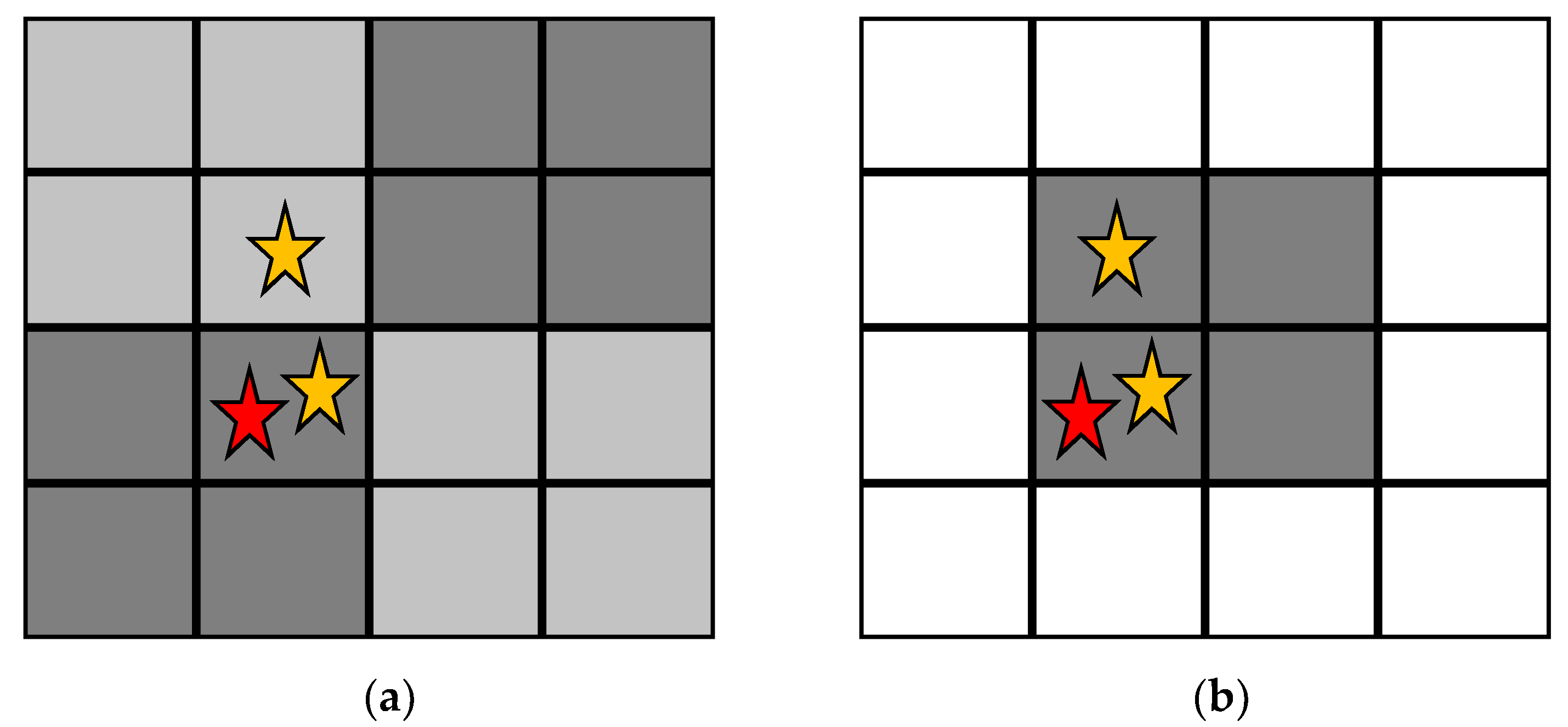
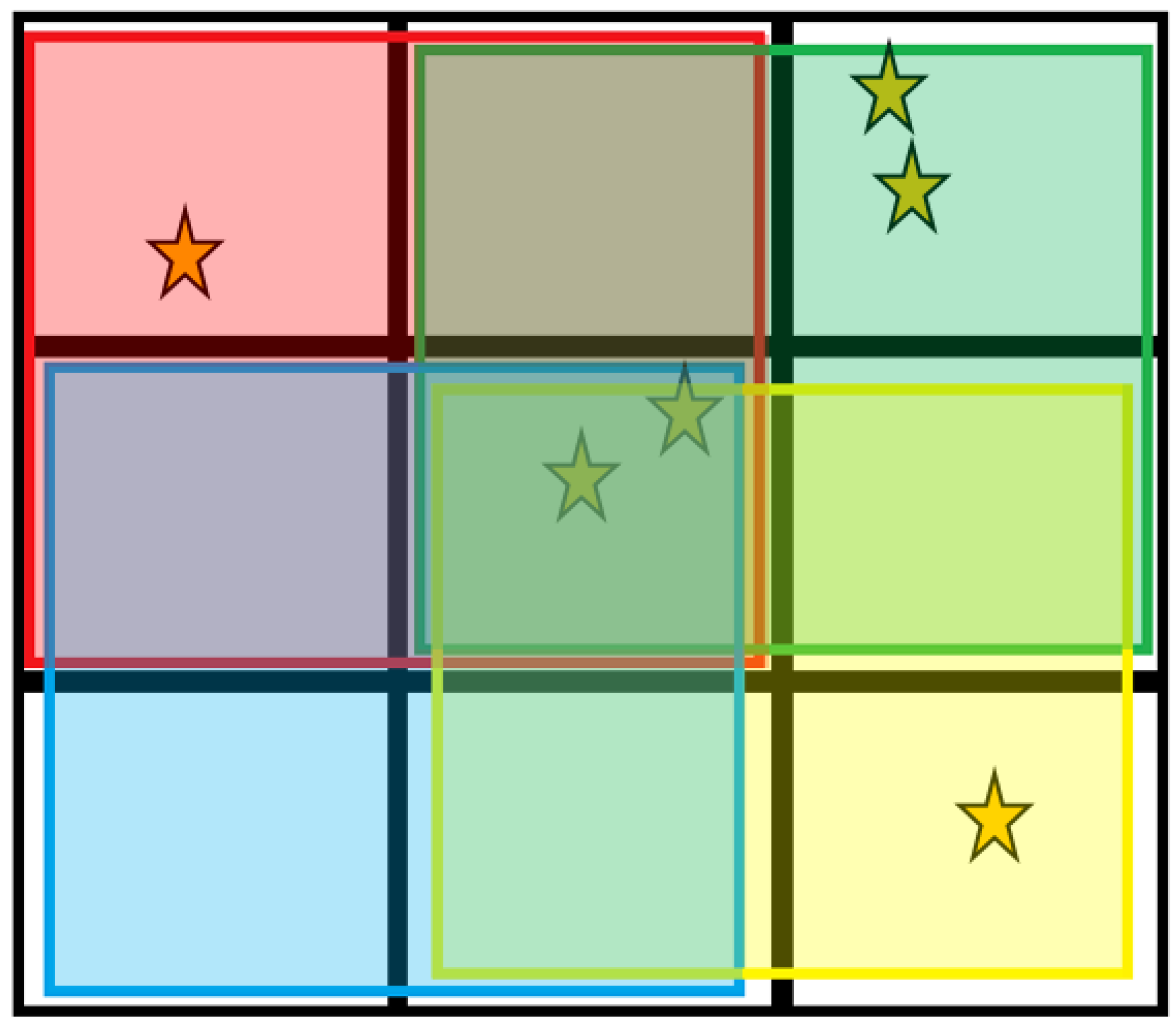
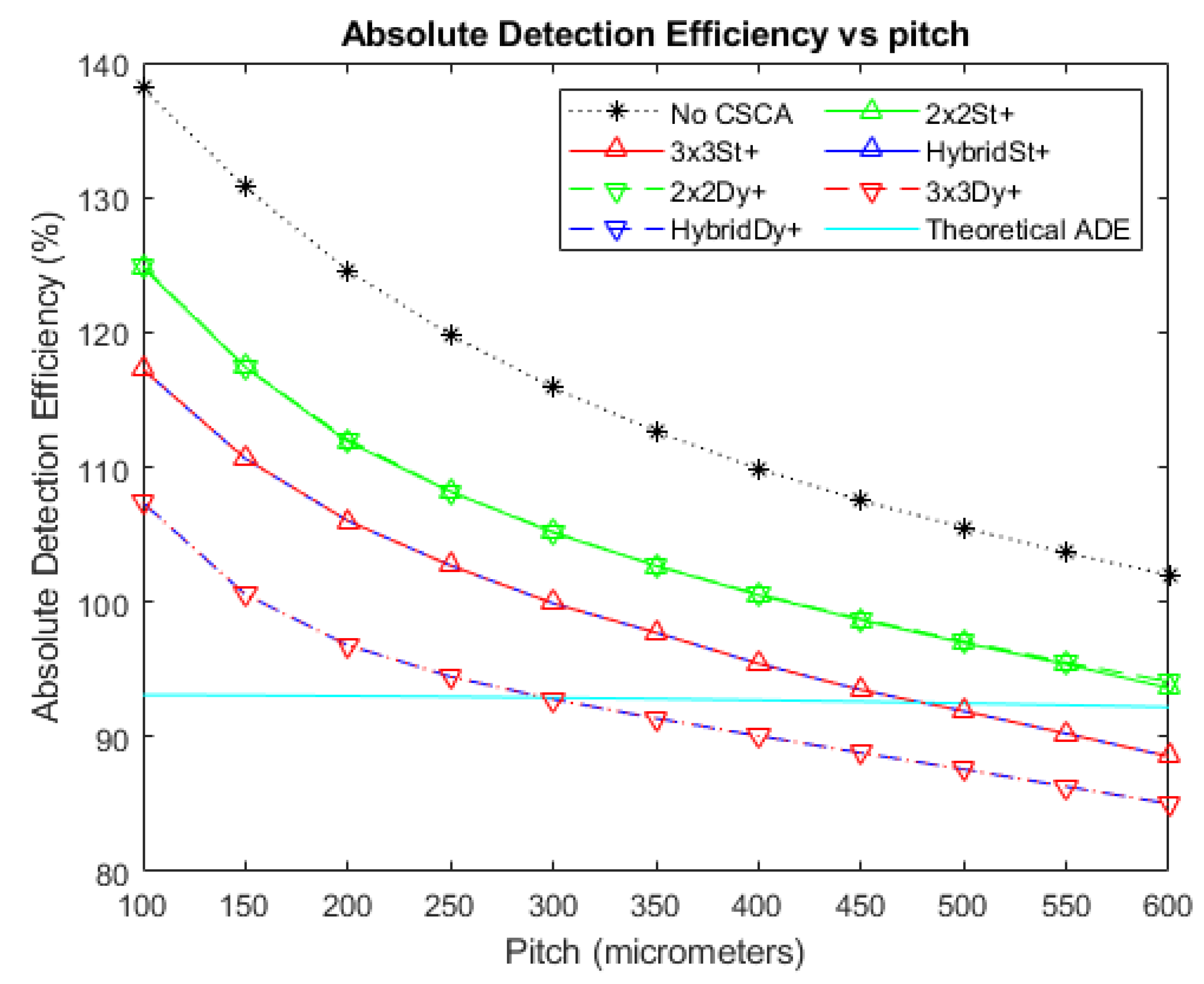
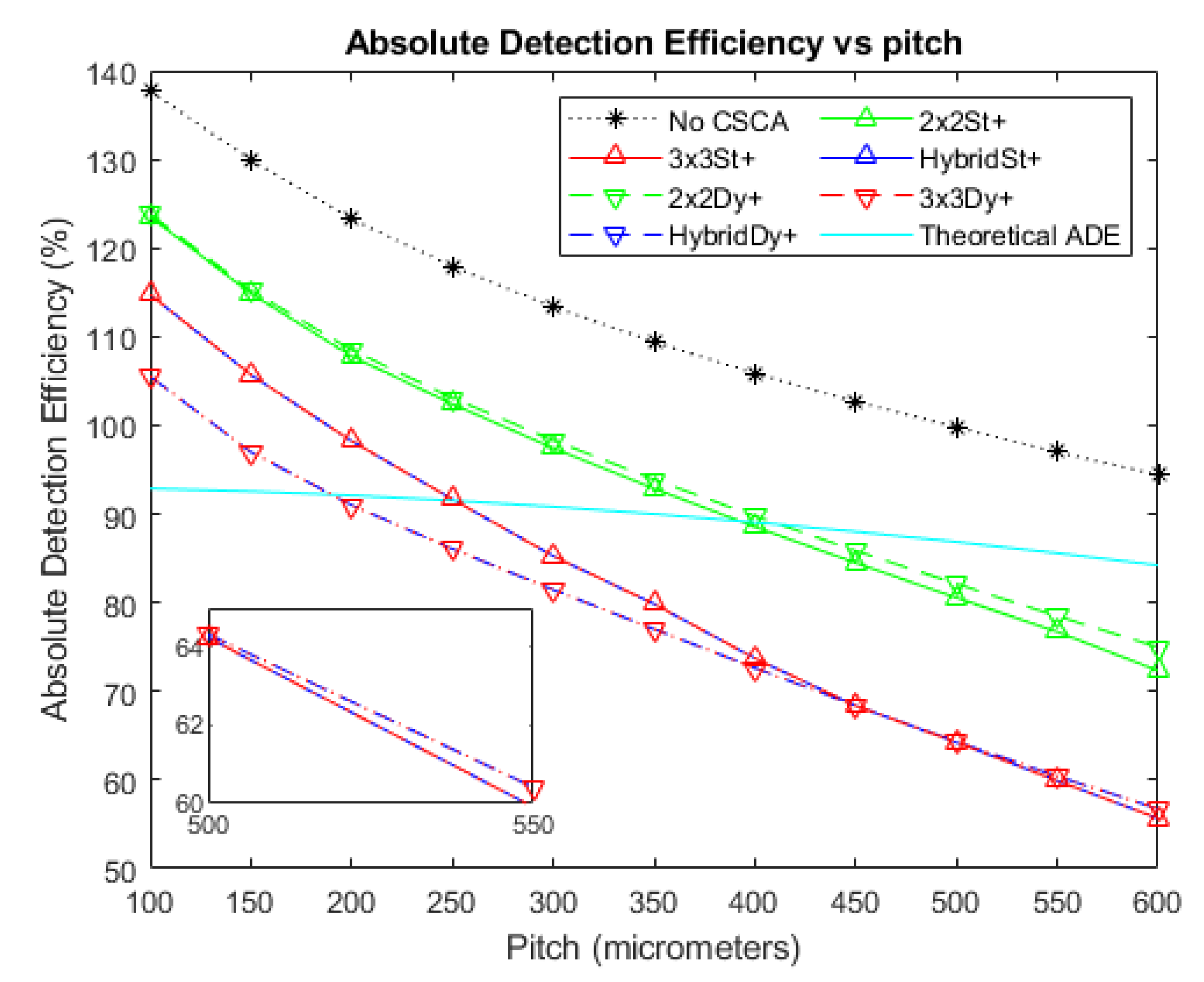
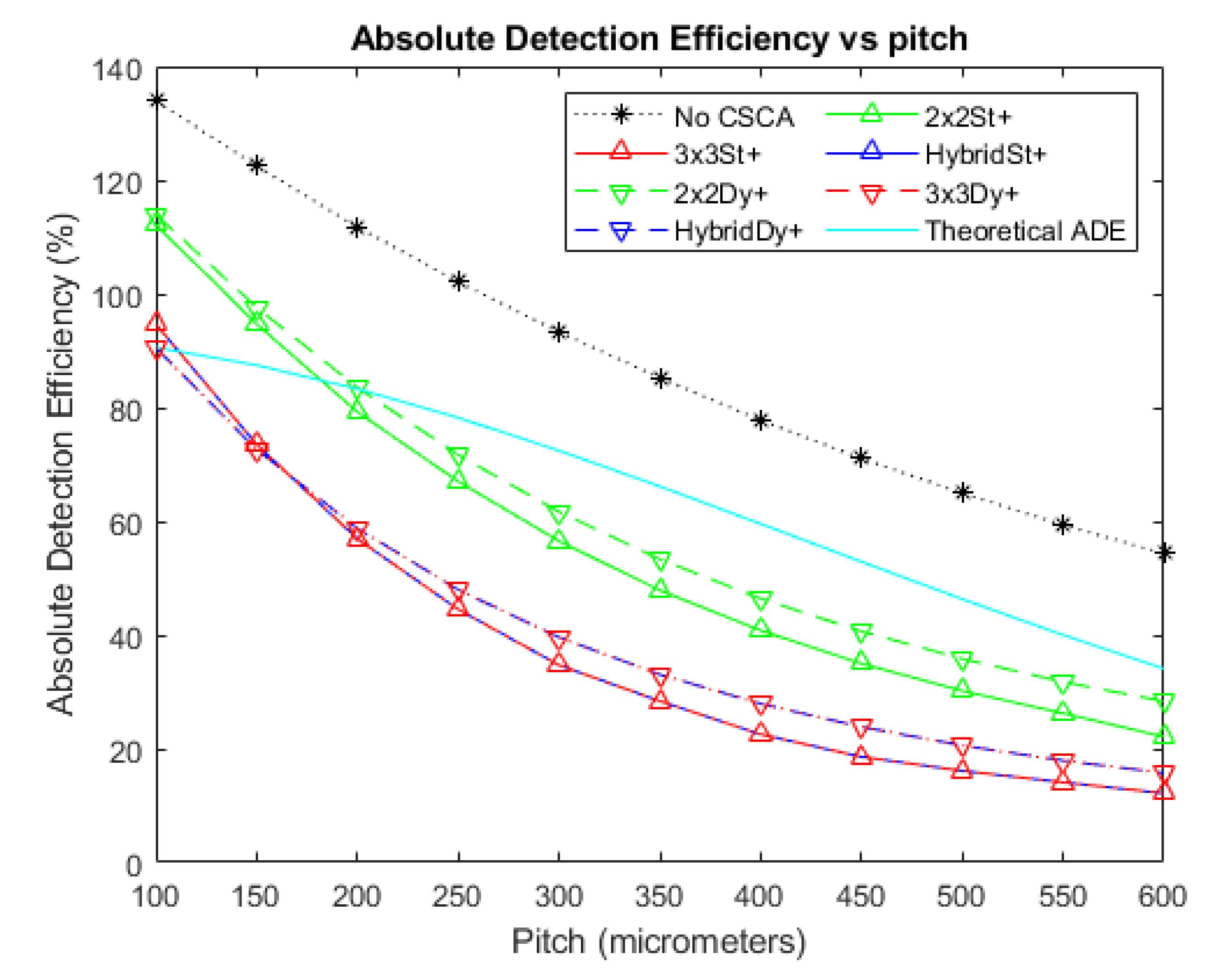
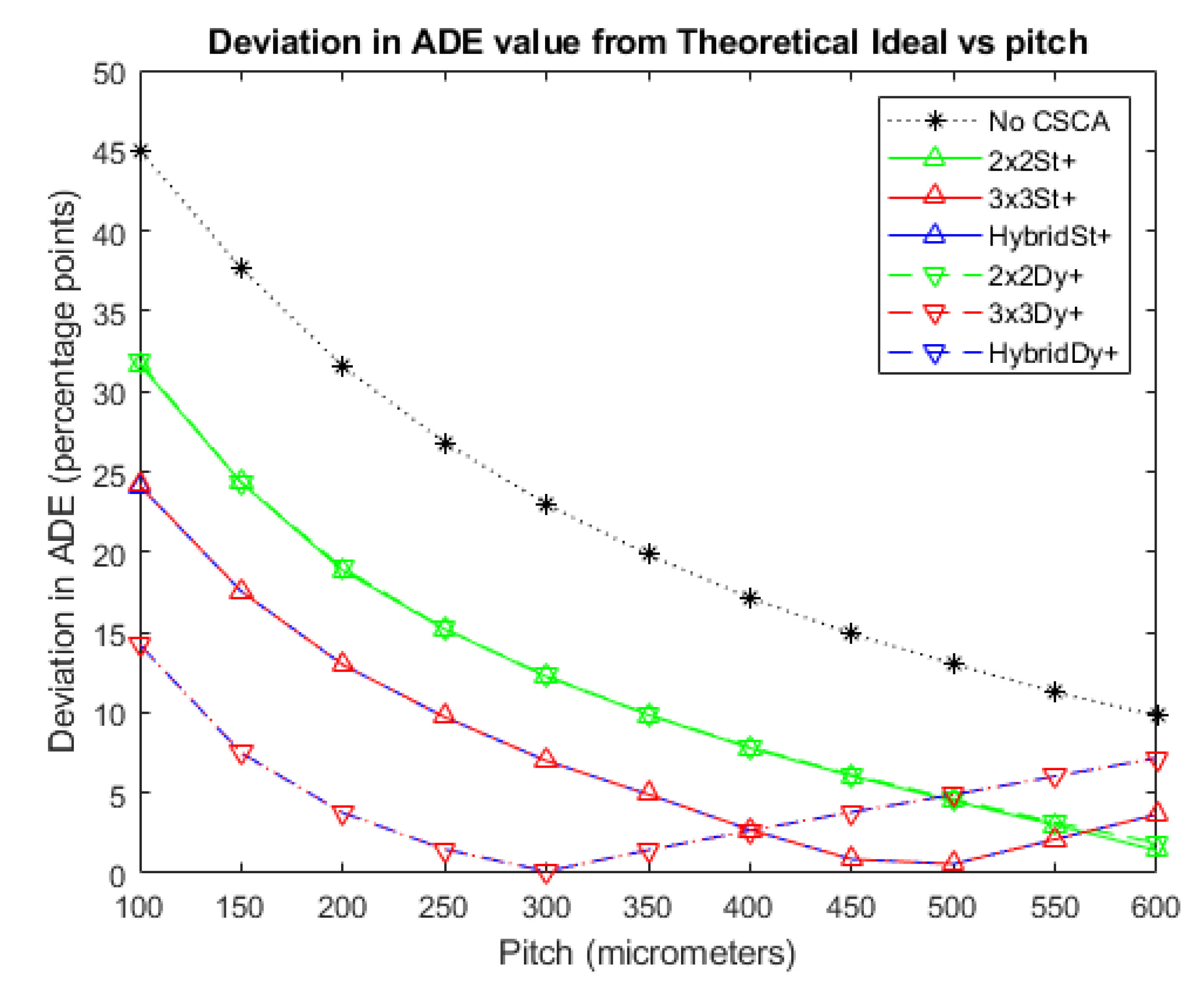
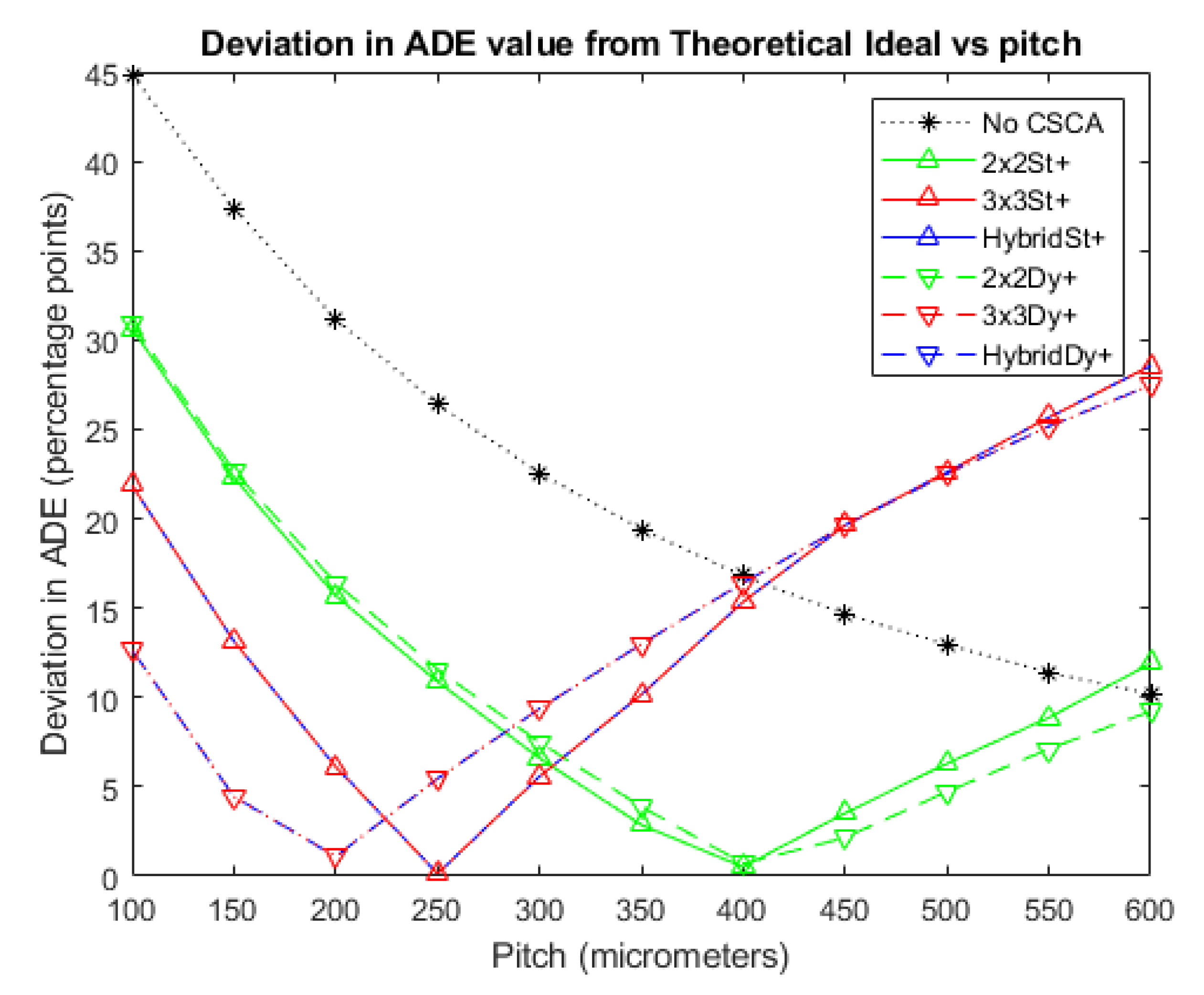


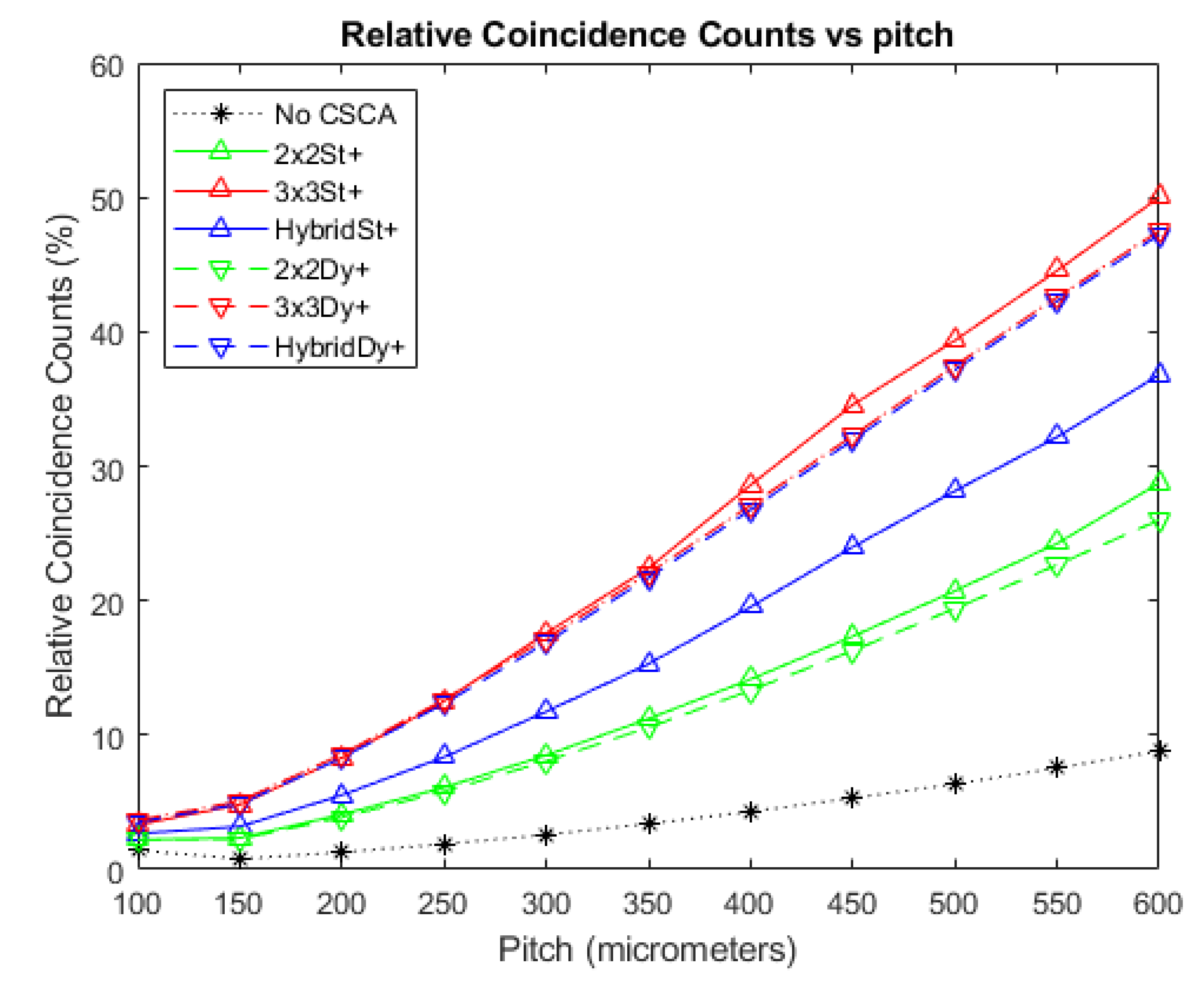
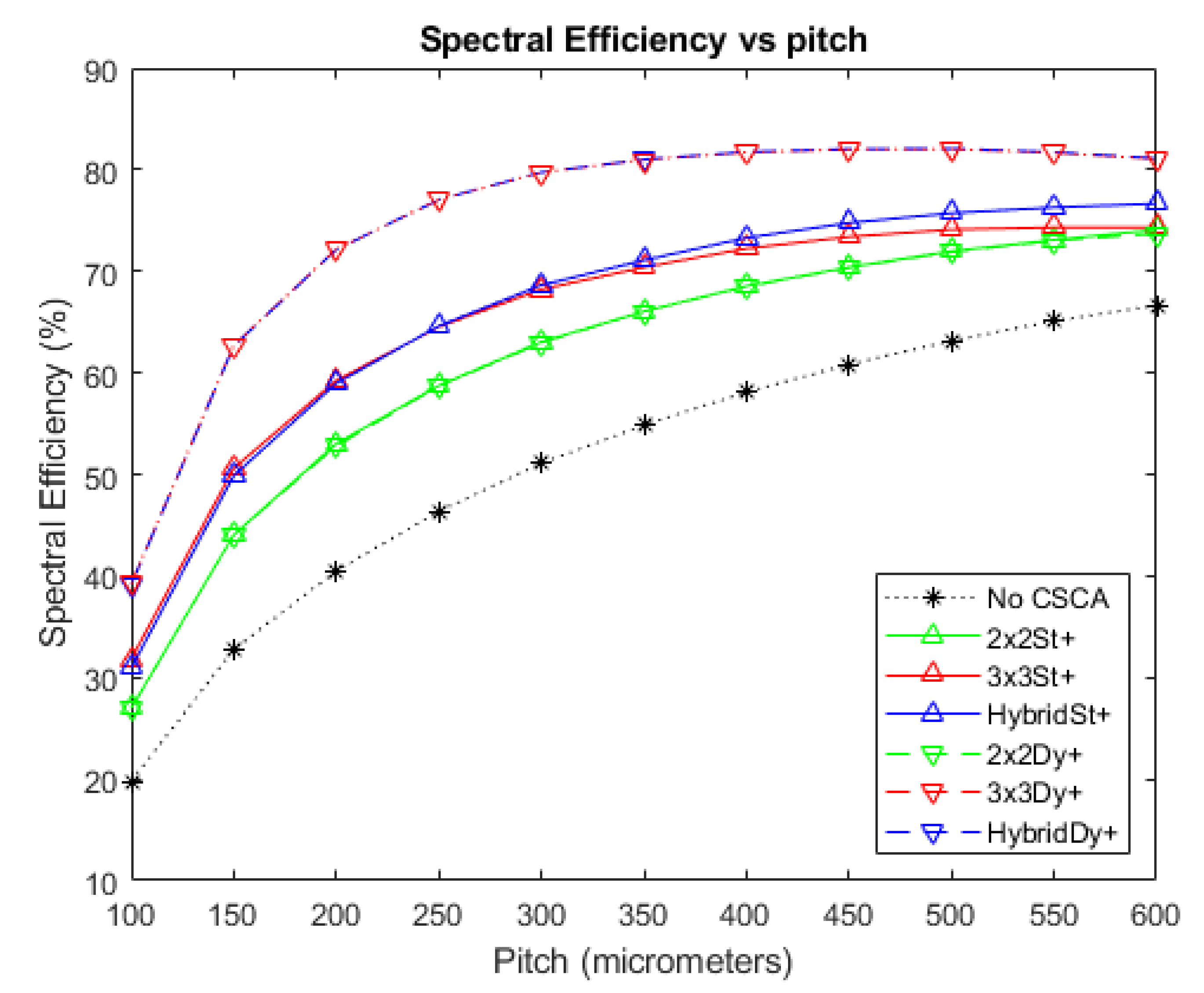
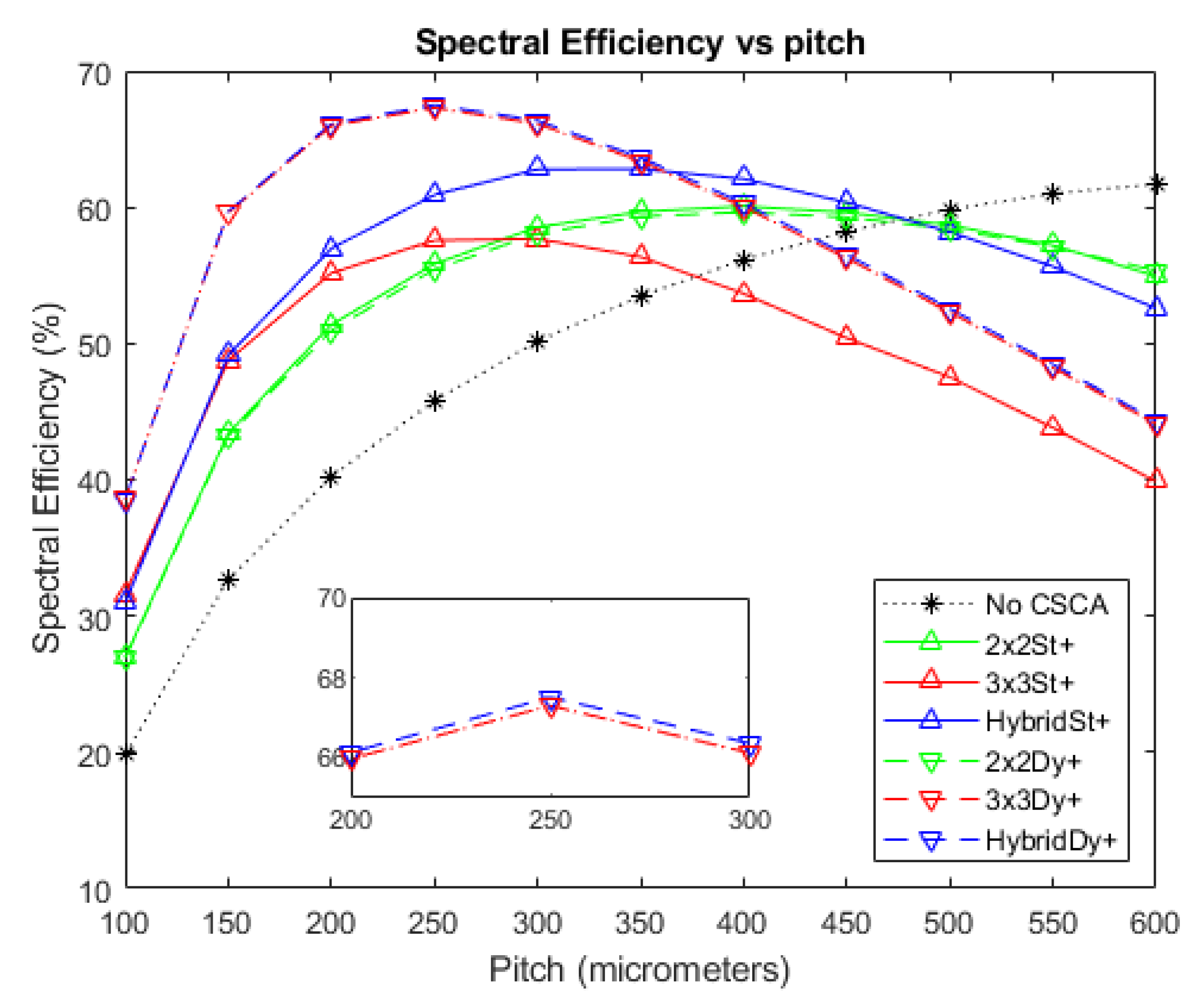

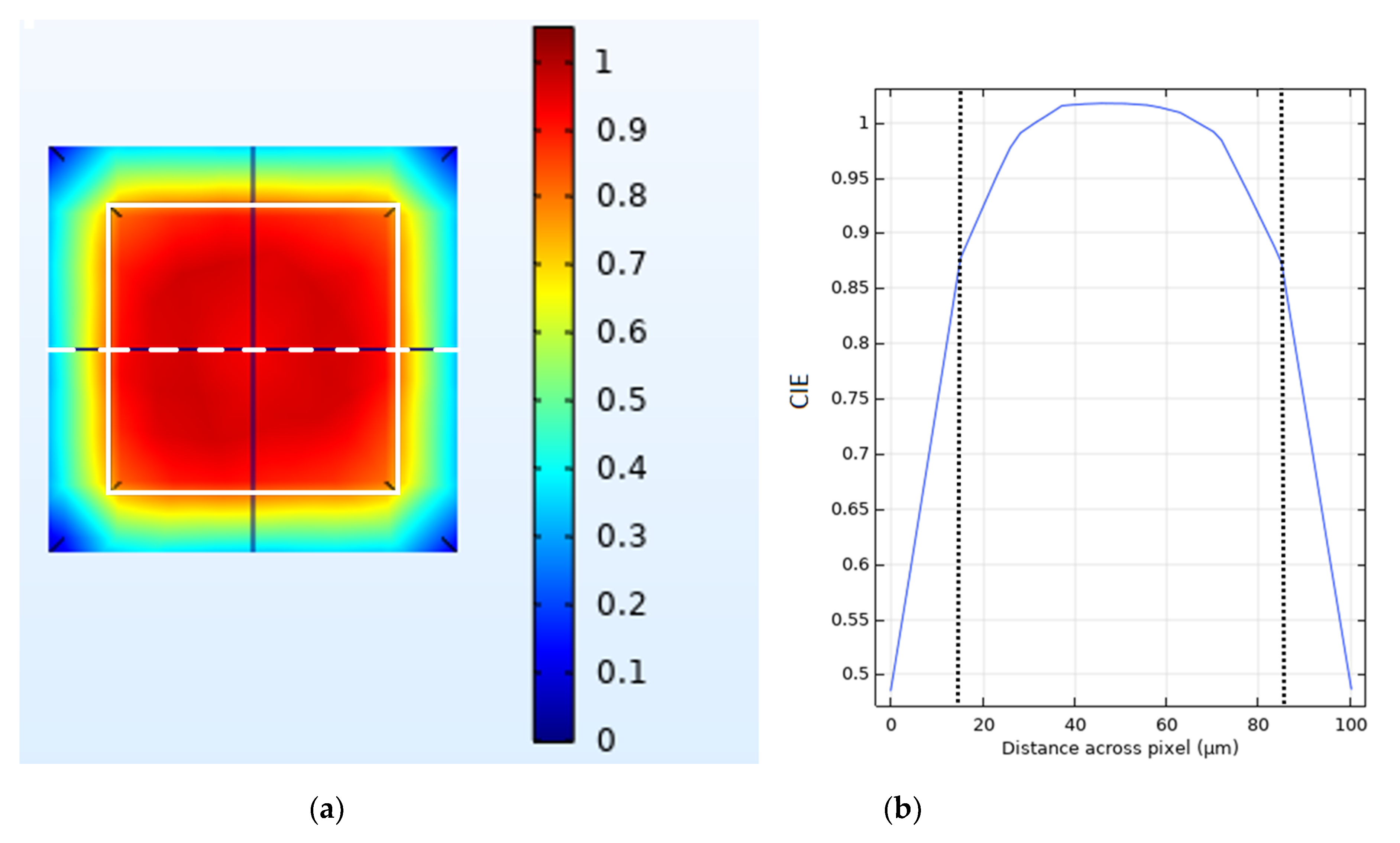

| Parameter | Symbol | Value | Unit |
|---|---|---|---|
| Mobility, electrons | µe | 1100 | cm2 V−1 s−1 |
| Mobility, holes | µh | 100 | cm2 V−1 s−1 |
| Lifetime, electrons | τe | 3.0 | µs |
| Lifetime, holes | τh | 2.0 | µs |
| Density | Ρ | 5850 | kg m−3 |
| Diffusion coefficient, electrons | De | 2.84 × 10−3 | m2 s−1 |
| Diffusion coefficient, holes | Dh | 2.58 × 10−4 | m2 s−1 |
| Relative permittivity | ε | 11.0 | - |
| CSCA Label | NS | NL |
|---|---|---|
| 2 × 2St+ | 2 × 2 | Static |
| 2 × 2Dy+ | 2 × 2 | Dynamic |
| 3 × 3St+ | 3 × 3 | Static |
| 3 × 3Dy+ | 3 × 3 | Dynamic |
| HybridSt+ | 3 × 3 and 2 × 2 | Static |
| HybridDy+ | 3 × 3 and 2 × 2 | Dynamic |
| Array Size (pixels) | Equivalent Pixel Pitch (µm) | 1 × 1 Max Count Rate | Static 2 × 2 Max Count Rate, S2Cmax | Dynamic 2 × 2 Max Count Rate, D2Cmax | D2Cmax/S2Cmax | Static 3 × 3 Max Count Rate | Dynamic 3 × 3 Max Count Rate | D2Cmax/S2Cmax |
|---|---|---|---|---|---|---|---|---|
| 210 × 210 | 100 | 44,100 | 11,025 | 17,647 | 1.6 | 4900 | 8301 | 1.7 |
| 84 × 84 | 250 | 7056 | 1764 | 2840 | 1.6 | 784 | 1342 | 1.7 |
| 60 × 60 | 350 | 3600 | 900 | 1455 | 1.6 | 400 | 689 | 1.7 |
| 42 × 42 | 500 | 1764 | 441 | 716 | 1.6 | 196 | 341 | 1.7 |
Publisher’s Note: MDPI stays neutral with regard to jurisdictional claims in published maps and institutional affiliations. |
© 2020 by the authors. Licensee MDPI, Basel, Switzerland. This article is an open access article distributed under the terms and conditions of the Creative Commons Attribution (CC BY) license (http://creativecommons.org/licenses/by/4.0/).
Share and Cite
Pickford Scienti, O.L.P.; Bamber, J.C.; Darambara, D.G. CdTe Based Energy Resolving, X-ray Photon Counting Detector Performance Assessment: The Effects of Charge Sharing Correction Algorithm Choice. Sensors 2020, 20, 6093. https://doi.org/10.3390/s20216093
Pickford Scienti OLP, Bamber JC, Darambara DG. CdTe Based Energy Resolving, X-ray Photon Counting Detector Performance Assessment: The Effects of Charge Sharing Correction Algorithm Choice. Sensors. 2020; 20(21):6093. https://doi.org/10.3390/s20216093
Chicago/Turabian StylePickford Scienti, Oliver L. P., Jeffrey C. Bamber, and Dimitra G. Darambara. 2020. "CdTe Based Energy Resolving, X-ray Photon Counting Detector Performance Assessment: The Effects of Charge Sharing Correction Algorithm Choice" Sensors 20, no. 21: 6093. https://doi.org/10.3390/s20216093
APA StylePickford Scienti, O. L. P., Bamber, J. C., & Darambara, D. G. (2020). CdTe Based Energy Resolving, X-ray Photon Counting Detector Performance Assessment: The Effects of Charge Sharing Correction Algorithm Choice. Sensors, 20(21), 6093. https://doi.org/10.3390/s20216093







